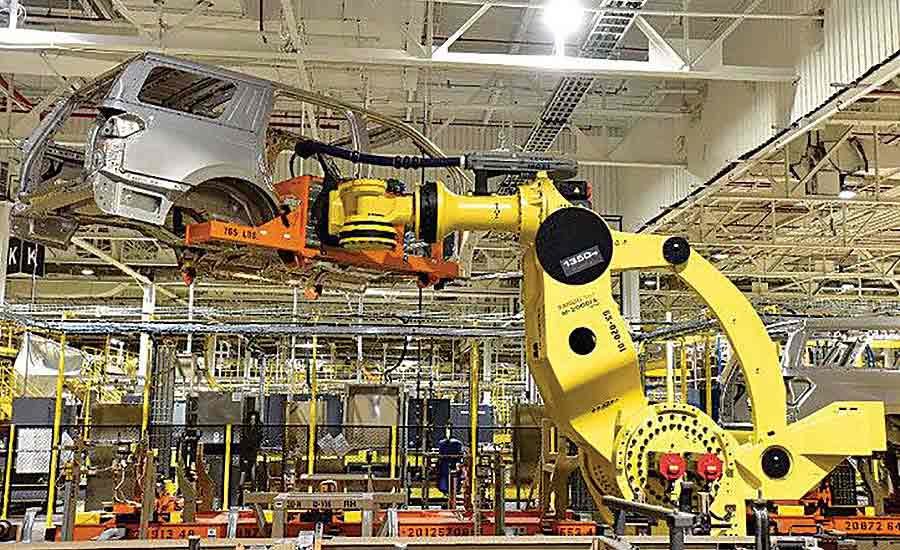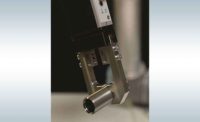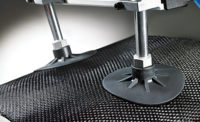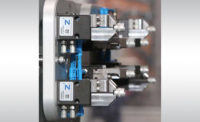Today, robots are capable of handling much larger and heavier payloads than in the past. Those applications require robust grippers that are up to the task.
Collaborative robots have been grabbing all the headlines recently, but a new breed of brawny, six-axis robots has slowly been gaining favor with some manufacturers. Vendors such as ABB, Fanuc, Kawasaki, Kuka and Motoman now offer machines that can routinely handle heavy parts or bulky subassemblies.
For instance, Fanuc boasts that its M-2000iA robot is one of the strongest on the market. It can handle payloads up to 1,350 kilograms. With a reach of more than 4,600 millimeters, the machine can also perform many tasks traditionally handled by cranes or hoists.
Those types of machines appeal to manufacturers of cast and forged metal parts. They’re also attractive to companies that need to move automotive floor pans, car bodies, rear-axle assemblies, household appliances or other big objects, such as aircraft, railcar and ship parts.
Allied Market Research predicts that demand for super heavy payload robots will grow 4 percent annually between now and 2025. Those types of machines particularly appeal to automotive manufacturers for applications in body shops, foundries and engine or transmission assembly plants.
“Today, many manufacturers want to automate more processes that involve large, heavy parts,” says Walt Hessler, sales and marketing specialist at PHD Inc. “They want to use more automation than they did in the past. We’ve responded by offering larger grippers and grippers with longer jaw travel.”
“More manufacturers want to pick up heavier parts with robots today,” notes Costas Charalambous, East regional sales manager at Zimmer Group US Inc. “They are trying to automate manual processes that were previously done with hoists or lift-assist devices. Automation is becoming a more attractive alternative.”
Size Matters
Large parts don’t necessarily have to be heavy. For instance, they could be light parts that are just really wide or long.
“We define large parts as starting somewhere around 100 cubic millimeters,” says Jesse Hayes, automation group product manager at SCHUNK Inc. “This could be anything up to about 2,000 cubic millimeters in volume.
“Small parts are more likely to be handled by a gripper in an automation system and are likely to have higher production volumes to justify [the cost],” Hayes points out. “Many larger parts are lower volume and, thus, it’s usually harder to justify the higher cost of an automated system. This trend has changed over the years to where safety and ergonomics drive a need to automate these other large parts handling applications.”
“‘Large’ can mean two different things,” says Hessler. “For instance, it can either refer to the dimensional size of a part or the weight of a part.
“Weight is certainly a determining factor, but even if a large part is made out of a lightweight material, such as foam, you still can’t pick it up with a small gripper,” explains Hessler. “The tooling that it takes to go around such a large part becomes so long that it affects the moment capacity, force and load on the jaws. A gripper that might have enough grip force probably wouldn’t have enough moment capacity.
“With regard to maximum grip forces, they will vary based on input air pressure and jaw tooling length and whether the jaw is closing or opening,” claims Hessler. “For instance, our GRR gripper can produce more than 750 pounds of total grip force at 100 PSI input pressure on gripper closure.
“As soon as you start putting more than 12 inches of tooling onto the jaw of a gripper, you have to make sure that there’s enough bearing capacity and side load to handle it,” notes Hessler. “If the tooling exceeds 12 inches, we consider it to be a large part.”
Most industry experts define “heavy” parts as anything that weighs more than 100 pounds. However, Josef Karbassi, vice president of the automation division at PIAB USA Inc., puts a different spin on it. “Heavy [simply means that] the weight of the object is so high that losing it can hurt people or cause severe damage to surrounding equipment,” he says.
A decade ago, large grippers would have referred to products that could handle 25 to 50 pounds. But, that’s no longer the case.
“Today, what we see in some of our applications for large, robust grippers is the requirement for repeatability, accuracy and dependability on par with their smaller brethren,” says Charalambous.
“A decade or so ago, grippers for larger and heavier parts tended to be very rough, with loose tolerances,” explains Charalambous. “The type of accuracy required for small grippers wasn’t as important for larger applications. But, as large, heavier payload robots have become more common, there’s now an increasing need to make large grippers with the same tolerances and repeatability as smaller grippers.
“As flexible manufacturing becomes more mainstream, we’re also seeing a need for grippers that are more adaptable,” claims Charalambous. “Larger servo-drive grippers that feature more adjustability [are now being developed].”
Numerous Applications
Large grippers are typically used for material handling applications, such as moving large rolls of paper or kegs of beer. But, they’re also used for a wide variety of automotive parts, such as castings for engine blocks or cylinder heads. Most applications involve foundries or machine tending.
“Large mechanical grippers are used to produce automotive transmission housings, in addition to brake rotors and drums used on trucks and construction equipment,” says Hessler. “Another common application involves aluminum wheels. Automotive wheels are getting bigger. In the past, everything was a 14-inch wheel. Today, they’re often more than 20 inches in diameter.
“A common application for our large robotic grippers are machining workcells where aluminum wheel castings are being loaded and unloaded for various milling or finishing operations,” Hessler points out.
“We’re also seeing more demand for applications that involve parts cleaning and washing,” says Hessler. “Manufacturers need grippers that can withstand harsh cleaning solutions and high pressures or temperatures.”
“We see a lot of applications for handling tires,” notes Matthias Kirchner, chief operating officer at IPR Robotics LLC. “But, as the auto industry continues to electrify, there will be increasing demand for large grippers that can handle batteries and battery packs.”
“Aerospace parts, such as jet engine components and landing gear, also require large grippers,” adds Hayes. “Other applications include wind turbine parts, railcar wheels and household appliances. In the appliance industry, we’ve seen end-of-line applications where large robots transfer finished products from an assembly line to a testing or packaging line.”
In the auto industry, applications that involve windshields or large sheet metal stampings, such as hoods, doors and floor pans, often use vacuum grippers.
“The components of a vacuum gripper would generally be lighter weight than a large mechanical gripper,” notes Michael Guelker, product manager for pneumatic grippers at Festo Corp. “It depends on what you’re handling. With palletizing applications, things are usually flat and rectangular, which lend themselves to vacuum grippers. Mechanical grippers are usually better at picking up different-shaped objects and parts with different orientations.”
“Large-area vacuum grippers tend to weigh less than full mechanical tools, which results in smaller robots and higher speeds,” says Mark Stankiewicz, robotic application specialist for vacuum automation systems at Schmalz Inc. “Also, there is much less of a possibility of damaging the part that is being picked, which can happen easily with a mechanical squeeze tool. In addition, we can specify the type of cup or material so that it is optimized for the surface we are picking.
“Industries that have traditionally used a medium level of automation and a lot of labor are being forced to increase their [use] of automation, due to the lack of available labor,” notes Stankiewicz. “We are seeing the largest growth in the area of logistics, but also in the wood products industry.
“Vacuum grippers are used in the furniture industry to load and unload wood router tables,” explains Stankiewicz. “They load 5-by-10-foot sheets of wood into the machines and then remove all the cut pieces at the same time so that the machines can keep running.”
New Products
Grippers for large, heavy parts are not necessarily just scaled-up versions of smaller grippers.
“With large grippers, guiding and support for the jaws and fingers is often more substantial and more robust,” says Guelker. “For instance, the guide rail may include ball bearings vs. a plain bearing panel on a smaller gripper.
“Often, there’s a little more flexibility in the mounting,” notes Guelker. “It might have some slots in the housing that allow you to mount slot nuts so you can configure it to your tooling. A traditional gripper would come with integrated, threaded mounting holes.”
“Today, fewer manufacturers want custom, one-off grippers like in the past,” adds Charalambous. “That’s why we offer several off-the-shelf grippers designed for large applications.”
Grippers designed for picking up large and heavy parts differ from standard grippers in that they usually need to be more rugged. They also must be able to support extremely long jaws. In addition, their guides need to be able to handle high acceleration and much larger payloads.
“Materials are important for large grippers, because the less payload the gripper takes, the better,” explains Charalambous. “Housings still tend to be aluminum, because they have to stay light.
“But, steel is primarily used to produce jaw guides, since it supports heavier and longer tooling fingers,” Charalambous points out. “Guides also need to be able to resist all the extra loads and kinetic energy that occurs when picking up a heavier part. Fingers used on large grippers tend to be longer and heavier, and made out of steel.
“Smaller grippers typically use a steel jaw, but you’re guiding it with aluminum,” says Charalambous. “When you’re picking up heavier parts, you can’t have a lighter or weaker material guiding a harder material, or the gripper housing will wear out quickly.”
One of the newest large grippers on the market is Zimmer’s GPH8000 series, which was unveiled recently at the Motek show in Germany. It can accommodate extremely long and heavy gripper fingers, can be ordered with either synchronous or asynchronous finger movement, and can optionally be fitted with an integrated clamping element to secure the workpiece in the event of a loss of pressure.
“The GPH8000 is a two-jaw, parallel, long-stroke gripper that features up to 150-millimeter stroke per jaw,” says Charalambous. “It’s designed for picking up wide, heavy parts. The GPH8000 series is eventually going to consist of five different sizes of gripping force and four different lengths.”
Pneumatic grippers are still popular for handling large, heavy payloads. They provide pure force and are lighter than electric grippers, because they don’t use a motor.
“If jaw speed is important, pneumatics would be a better option,” says PHD’s Hessler. “Electric grippers are fast, but pneumatic products are quicker.
“Pneumatic grippers are still widely used, because they’re so simple to operate and people have been using them for years,” explains Hessler. “If you only look at initial upfront costs, electric grippers are more expensive.”
However, there are long-term economic considerations that engineers must consider. “Electrically, the only time you’re using power is when you’re driving the gripper,” Hessler points out. “Pneumatically,
you’re using power all of the time.
“Many engineers want to go electric for a variety of reasons,” claims Hessler. “It eliminates things such as air lines, fittings and valves. Electrically driven grippers can also control the acceleration, position and velocity of the jaw. They are more efficient and provide more feedback than pneumatic alternatives.”
PHD has specialized in pneumatic grippers for decades, but it has been expanding into electrically actuated grippers to meet growing demand. For instance, the company recently developed an electric version of its popular GRR gripper for large objects.
“The EGRR high-capacity electric parallel gripper offers many of the same benefits as the pneumatic,” says Hessler. “It provides high grip force, long jaw travels and high jaw loads, with servomotor control on jaw acceleration, velocity and position feedback. This heavy-duty end effector’s rugged design and jaw construction can withstand high impact and shock loads.”






